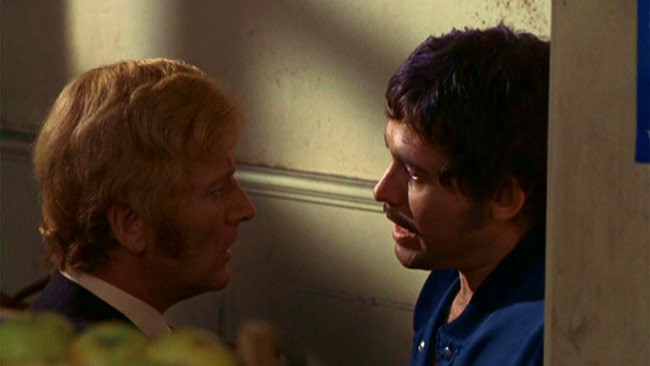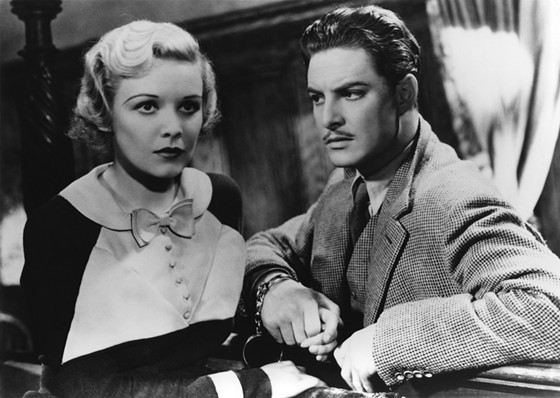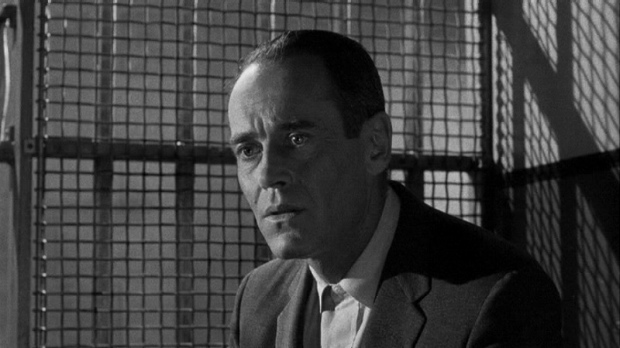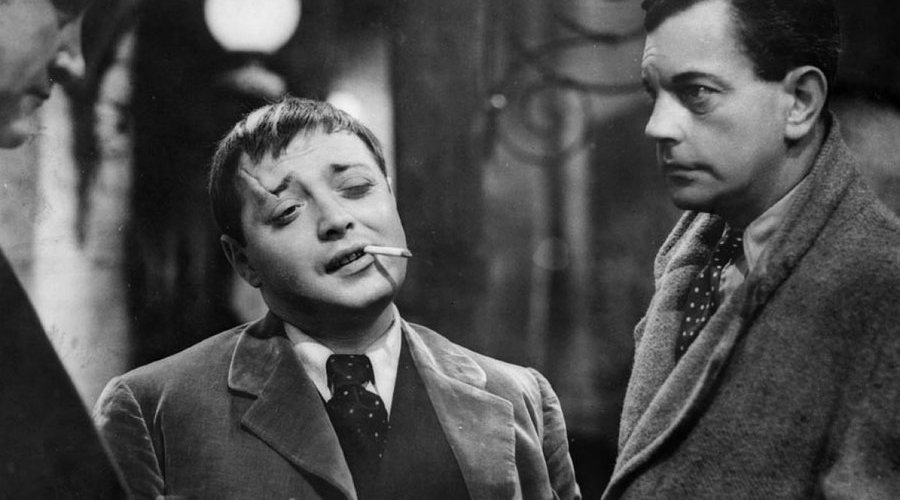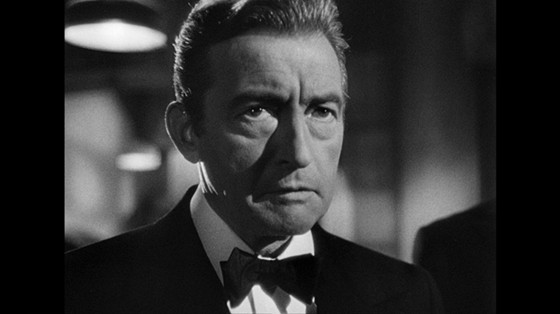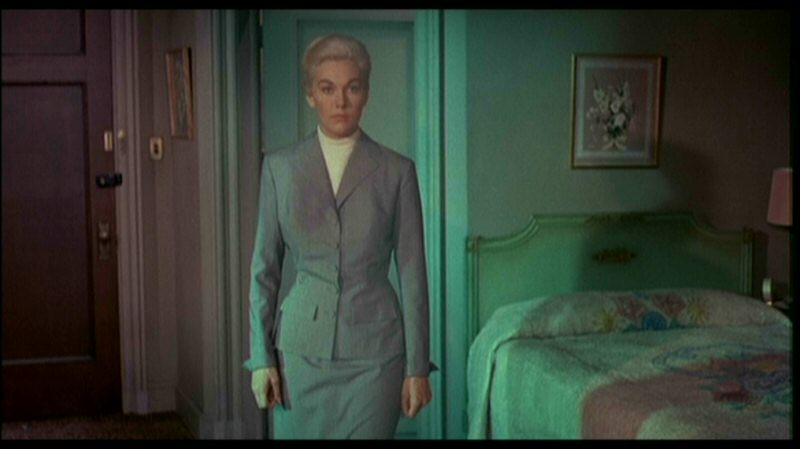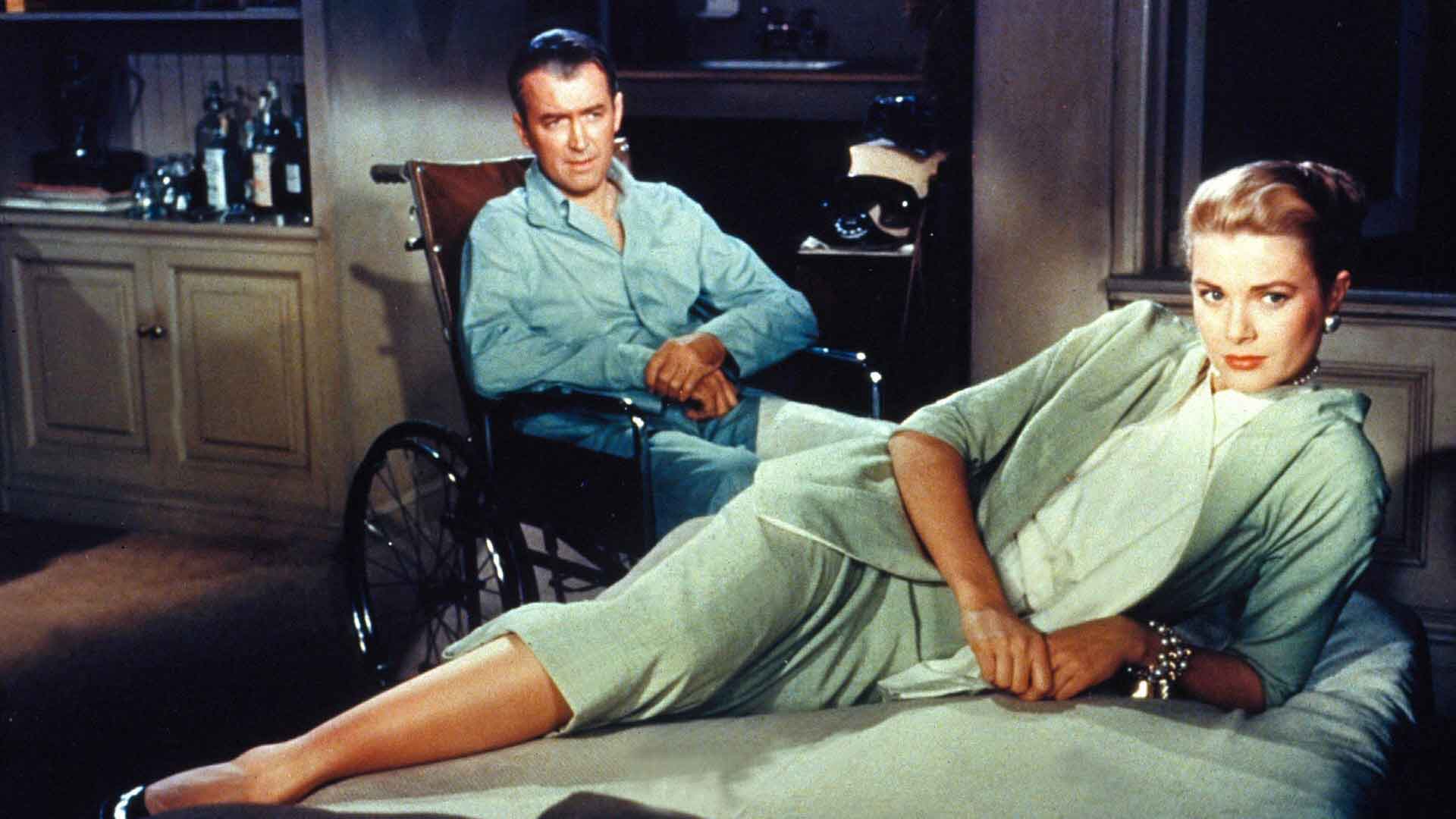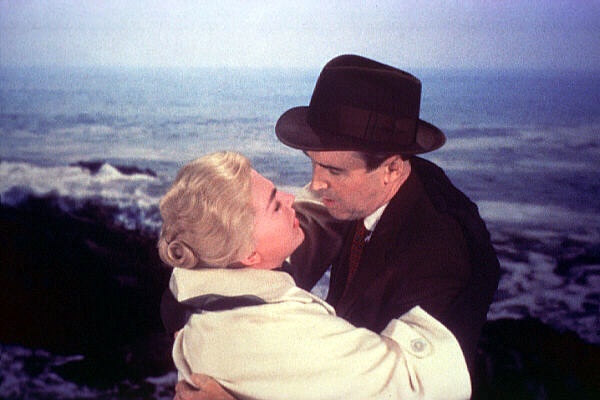17. Barry Foster as Bob Rusk in Frenzy (1972)
It’s well known that Hitchcock wanted Michael Caine for the part of Bob Rusk in Frenzy, but when the actor turned him down due to the unpleasant characteristics of Rusk’s personality, Hitchcock turned to Foster, a British actor who somewhat resembled Caine. A professionally trained thespian, Foster had been a frequent presence on the British stage and in films such as Ryan’s Daughter before he appeared in Frenzy.
As Bob Rusk, Foster had to perform the brutal rape and murder scene with Brenda Blaney (Barbara Leigh-Hunt) and the scene in which he rides in the back of a potato truck to pry his tie pin out of the dead hand of Babs (Anna Massey). It was presumably the brutality of these two scenes that drove Caine away from playing the character of Rusk.
But Foster performed all his scenes in Frenzy admirably. His depiction of the character of Bob Rusk allowed the audience to even sympathize with him at times (before he rapes and murders Brenda, for instance, he pleas for her understanding and help). In some ways, he is more likable than Jon Finch’s Dick Blaney, who spends most of the movie whining and moaning about his bad luck and misfortune.
Foster performed a difficult role well, and Frenzy went on to critical kudos and box office success. Foster turned to TV roles often after Frenzy and appeared frequently on the British stage in the 1990’s, eventually passing away in 2002 at the age of 74. His role for Hitchcock as the best remembered of his career.
16. Robert Donat as Richard Hannay in The 39 Steps (1935)
Hitchcock needed a great actor to play Richard Hannay, the first of his truly well known falsely accused protagonists, who goes on the run to prove his innocence in The 39 Steps. For this part, he turned to the well known British actor Robert Donat. Donat had just returned from Hollywood, where he made his only American film, the Count of Monte Cristo in 1934. But deciding that he didn’t like Tinseltown, Donat came back to his native country just in time to land the part of Hannay.
As he would later with Cary Grant, Hitchcock used Donat’s charm and wit to great effect in the film; the audience is on Hannay’s side from the moment that he steps into the Music Hall and gets involved with a spy named Annabelle Smith.
Hannay eventually meets and wins over Pamela (Madeleine Carroll), who comes to believe his story despite her early skepticism. Together they are able to clear Hannay’s name and keep the vital government secrets from leaving the country. The film was a major success, largely due to the screen presence of Donat, and Hitchcock became an internationally known director.
Donat’s role in Goodbye Mr. Chips in 1939 capped his career, as he garnered the Academy Award for Best Actor against formidable competition, but his career would not be a long one. Plagued by asthma, Donat missed out on several roles that could have enhanced his career, and he passed away at the young age of 53 in 1958, best known for his roles in British films two decades earlier.
15. Henry Fonda as Manny Balestrero in The Wrong Man (1956)
Hitchcock returned to Warner Bros. in 1956 to make a film based on the true story of Manny Balestrero, a New York musician wrongly accused of holding up an insurance company office in his neighborhood. For the part of Manny, Hitchcock needed someone whose image personified dignity and earnestness, and he had to look no farther than Henry Fonda to find that man.
A native of Nebraska, Fonda had come to Hollywood in the 1930’s and gradually established himself as one of the film colony’s most bankable leading men. In 1940, he played the role with which some will forever identify him, that of Tom Joad in John Ford’s film version of The Grapes of Wrath. After serving in the navy during World War II, Fonda took a seven year break from films to work in theater, only to return in the title role of Ford’s Mister Roberts in 1955.
The Wrong Man was filmed largely on location in the New York neighborhood where the Balestreros family lived and was shot in grimy black and white, as opposed to Hitchcock’s recent Technicolor efforts for Paramount. Fonda was perfect in projecting the image of an average man, down on his luck, who must struggle against the forces of authority and back luck to prevail.
Fonda’s honest, dignified persona worked perfectly for the part, causing the audience to wonder how anyone could accuse someone with such a believable face of a dastardly crime. Manny is cleared eventually, but not before his life is severely damaged and his wife Rose (Vera Miles) ends up in a sanitarium.
Fonda went on to finish out his legendary career with many memorable roles, eventually winning the Academy Award for Best Actor in his last picture, On Golden Pond, before passing away in 1982 at the age of 77.
14. Peter Lorre as Abbott in The Man Who Knew too Much (1934)
Lorre was a German actor who starred as the child killer in Fritz Lang’s 1930 classic M. Having left Germany in 1933 in the wake of the takeover of the Nazi party, Lorre immigrated to England where Hitchcock cast him as Abbott, the leader of the ring of assassins in The Man Who Knew too Much.
The most amazing aspect of his performance is the fact that Lorre was unable to read or speak English at the time, so he had to mostly learn his lines phonetically. Despite this, Lorre gives an amazing performance in his usual creepy and understated style; half man, half child, he is chilling nonetheless, as his character seems to be perpetually on the verge of some insane outburst.
After appearing in the film, Lorre and his wife went to America, where he eventually did learn English. During Lorre’s early years in Hollywood he starred in the Karl Freund classic Mad Love, as well as the Mr. Moto series.
Also finding success as a character actor, he appeared in The Maltese Falcon, Casablanca and Arsenic and Old Lace, before experiencing a career downturn after World War II. After doing numerous television appearances, Lorre bounced back in the 1960’s in several Roger Corman films such as The Raven. Bothered by ill health, he died of a stroke in 1964 at the premature age of 59.
13. Claude Rains as Alex Sebastian in Notorious (1946)
The English born Rains was, like Lorre, an emigre to Hollywood, who found success both as a lead actor and a character player. An emerging star at Warner Brothers in the 1930’s, Rains was featured in supporting parts in Casablanca, Now,Voyager and Mr. Skeffington, before Hitchcock picked him to play Alex Sebastian, the Nazi agent who falls in love with Ingrid Bergman’s Alicia Huberman.
As some critics have pointed out, Sebastian is eminently more sympathetic in the film than his rival for Alicia’s affections, T.R. Devlin (Cary Grant). Devlin is cold and unresponsive to Alicia, driving her into the arms of Alex, who falls head over heals in love with the double agent. When he discovers that Alicia has duped him, Alex must scramble to save his own skin, and he plots her murder by slow poisoning.
Rains handled the difficult part with his usual professional effectiveness, and Notorious was a huge hit. He went on to an extensive career as a character actor throughout the 1950’s and 60’s, including appearances in Lawrence of Arabia and The Greatest Story Ever Told. A four time nominee for the Academy Award for Best Supporting Actor, Rains unfortunately never won, but his lengthy and impressive career was testimony to his high quality as an actor. Rains passed away in 1967 at the age of 77.
12. Dame Judith Anderson as Mrs. Danvers in Rebecca (1940)
Hitchcock’s films featured many great supporting roles, but possibly none was greater than Dame Judith Anderson’s turn as Mrs. Danvers in his first American film, Rebecca. Anderson was an Australian born actress, who came to America in the early 20’s and established herself as one of the preeminent theatrical stars of the era. She played Lady Macbeth twice, once on the London stage opposite Lawrence Olivier, and once on the American stage opposite Maurice Evans.
Hitchcock cast her as Mrs. Danvers, the housekeeper of Manderley, who is devoted to the memory of the deceased former lady of the house, Rebecca, and a thorn in the side of the new Mrs. de Winter, played by Joan Fontaine.
As Mrs. Danvers, Anderson played a woman possessed with keeping alive the memory of her former mistress. She walks the halls of Manderley in a ghostly fashion, frequently appearing a scene suddenly, as if she was just there out of the blue. In one memorable scene, she coaxes the new Mrs. de Winter to end it all and commit suicide, as she can never live up to standards set by the unattainable Rebecca.
In the final moments of the film, Mrs. Danvers loses her mind and sets the stately home on fire, unwilling to turn over control of the estate to the new interloper, and she dies in a blaze of glory. For her scene stealing part, Anderson was awarded with an Academy Award nomination for best supporting actress. She lost, but went on to a successful, lengthy career, finally passing away at the age of 94.
11. Kim Novak as Madeleine Elster/Judy Barton in Vertigo (1958)
Vera Miles was originally set to play the dual part of Madeleine Elster and Judy Barton, the woman who impersonates her, in Hitchcock’s 1958 film, but Miles got pregnant just as production was about to begin and lost the part.
Hitchcock then turned to Kim Novak, Columbia Studios blonde bombshell, who had recently appeared in the hits Picnic and The Man With the Golden Arm. Novak felt attracted to the part immediately, and while critics questioned her performance in the film, audiences for the most part seemed to like her.
As Madeleine, Novak is mysterious and alluring, tempting James Stewart’s Scotty Ferguson into falling in lover with her. She seems torn about going through with the plan that has been concocted by Gavin Elster (Tom Helmore) but goes ahead with it anyway, convincing Scotty that he has, in fact seen Madeleine fall to her death from the Mission Tower.
Later, she reappears as Judy Barton, a character who seems to have more in common with the real Novak. As Judy, she encourages a new romance with Scotty, but the two are doomed to failure as Scotty learns the truth. Novak did not try to overact the part, instead playing it with her simple and naturalistic style, which worked to perfection.
After Vertigo, her career slowly declined in the 1960’s, and she ended up totally retired after 1991. She did a number of appearances to promote the restoration of Vertigo in 1996, however, and she now lives on a farm in Oregon, happily married to her second husband.
10. Grace Kelly as Lisa Fremont in Rear Window (1954)
Everyone knows that Hitchcock was obsessed with blondes, and Grace Kelly epitomized the ‘Hitchcock blonde’ in the three films that she starred in for the director in the 1950’s. After appearing as Margot in Dial ‘M’ for Murder, she next took on the part of Lisa Carol Fremont, the girlfriend to James Stewart’s photographer in Rear Window.
Lisa enters the film in one of Hitchcock’s most memorable shots; Jeffries POV shot as he wakes from a dreamy sleep being kissed in slow motion by the gorgeous Lisa. From there on, she seems to have the photographer in the palm of her hand as she cajoles him about his choice of career and his unwillingness to settle down and open a New York fashion photography studio as Lisa wants.
But eventually, the adventurous Lisa can’t help but get caught up in Jeffries rear window dramatics, finally believing along with him that Thorwald (Raymond Burr) has murdered his wife. She ends up risking her neck by climbing into Thorwald’s apartment to search for the incriminating wedding ring, and almost ends up murdered herself when the killer comes home suddenly.
For her efforts, Lisa is given a trip to jail, but she ends up with the upper hand in the relationship as Jeffries breaks his other leg and must remain in a cast. For her beauty, allure and great acting chops, Grace Kelly earned the love and admiration of Alfred Hitchcock as well as his audience, and she also earned another chance to act for the director the next year in To Catch a Thief.
9. James Stewart as Scotty Ferguson in Vertigo (1958)
One of the great American actors, Stewart first established himself in the 1930’s in films such as You Can’t Take it With You and Mr. Smith Goes to Washington.
After winning the Academy Award for The Philadelphia Story, Stewart served in the Air Force during World War II. He had trouble getting his career back on track after the war, but by the 1950’s was once again one of Hollywood’s most bankable actors, and his appearance in Vertigo as Scotty Ferguson, the retired San Francisco police detective bothered by acrophobia, was his fourth and final film with Hitchcock.
Although Vertigo was not an audience favorite on its release, the film has been reevaluated and is now considered Hitchcock’s greatest achievement, and Stewart’s performance as Scotty is certainly one reason this film has risen in the ranks.
As Scotty, Stewart is a man disabled by his fears and obsessions. He falls hopelessly in love with a woman that he believes to be Madeleine Elster, his friend’s wife, and is racked with guilt when he thinks that he has been unable to prevent her from falling to her death. Scotty finally cracks up under the stress of it all, and he ends up in a mental hospital. When he gets out, his obsession with the dead Madeleine forces him to try to remake the new woman that he has met into his lost love.
Stewart played this complex part in a way that made it easy for audiences to identify with him; never does the audience doubt the truth of his raw feelings as he goes through a roller coaster ride of emotions in the film. Vertigo was met with criticism on its initial release, and Hitchcock himself believed that Stewart was too old to be believable in the part of Scotty, but in hindsight it looks like great casting as the film has became the favorite of many.
